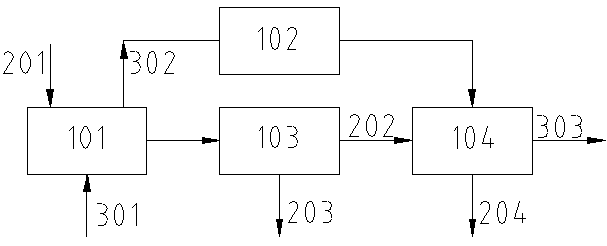Method and device for treating flue gas containing nitrogen oxides
A technology of nitrogen oxides and flue gas, applied in the direction of microorganism-based methods, chemical instruments and methods, biochemical cleaning devices, etc., can solve problems such as pollution, high investment costs, ammonia escape, etc., to avoid poisoning and improve carbon sequestration Efficiency, effect of increasing solubility
- Summary
- Abstract
- Description
- Claims
- Application Information
AI Technical Summary
Problems solved by technology
Method used
Image
Examples
Embodiment 1
[0042] (1) In a 10L photobioreactor, add 6L of the prepared microalgae culture medium, adjust the pH of the microalgae culture medium to 10 with NaOH, and insert 0.9L of Pseudochlorella kelvinia FSH-Y3 seed liquid for cultivation. Into the flue gas, CO in the flue gas 2 The content of NO is 5v%, the NO content is 0.03v%, and the ventilation volume is 0.5vvm. The light intensity for cultivation was 5000Lux, the cultivation temperature was 25°C, the light cycle was 24h, and the light-dark time ratio was 14:10. In the collected exhaust gas, CO 2 The removal rate is 85%, and the NO removal rate is 80%.
[0043] (2) After 5 days of culture, microalgae cells and filtrate were harvested by centrifugation. Determine dry cell weight and lipid content. After vacuum freeze-drying at -60°C to constant weight, the dry weight of the algae powder was measured, the biomass production was calculated, and the total lipid content was measured by the n-hexane: ethyl acetate method. After tes...
Embodiment 2
[0046] (1) In a 10L photobioreactor, 6L of the prepared microalgae medium was added, the pH of the microalgae medium was adjusted to 11 with NaOH, and 1.0L of Pseudochlorella kelvinii FSH-Y3 seed liquid was added for cultivation. Into the flue gas, CO in the flue gas 2 The content of NO is 10v%, the NO content is 0.05v%, and the ventilation volume is 0.5vvm. The light intensity for cultivation was 5000Lux, the cultivation temperature was 25°C, the light cycle was 24h, and the light-dark time ratio was 14:10. CO in collected exhaust gas 2 The removal rate is 80%, and the NO removal rate is 75%.
[0047] (2) After 6 days of culture, microalgae cells and filtrate were harvested by centrifugation. Determine dry cell weight and lipid content. After vacuum freeze-drying at -60°C to constant weight, the dry weight of the algae powder was measured, the biomass production was calculated, and the total lipid content was measured by the n-hexane: ethyl acetate method. After testing,...
Embodiment 3
[0050] (1) In a 10L photobioreactor, add 6L of the prepared microalgae culture medium, adjust the pH of the microalgae culture medium to 12 with NaOH, insert 1.2L of Pseudochlorella kelvinia FSH-Y3 seed liquid for cultivation. Into the flue gas, CO in the flue gas 2 The content of NO is 40v%, the NO content is 0.05v%, and the ventilation volume is 0.3vvm. The light intensity for cultivation was 5000Lux, the cultivation temperature was 25°C, the light cycle was 24h, and the light-dark time ratio was 14:10. CO in collected exhaust gas 2 The removal rate is 60%, and the NO removal rate is 75%.
[0051] (2) After 6 days of culture, microalgae cells and filtrate were harvested by centrifugation. Determine dry cell weight and lipid content. After vacuum freeze-drying at -60°C to constant weight, the dry weight of the algae powder was measured, the biomass production was calculated, and the total lipid content was measured by the n-hexane: ethyl acetate method. After testing, th...
PUM
 Login to View More
Login to View More Abstract
Description
Claims
Application Information
 Login to View More
Login to View More - R&D
- Intellectual Property
- Life Sciences
- Materials
- Tech Scout
- Unparalleled Data Quality
- Higher Quality Content
- 60% Fewer Hallucinations
Browse by: Latest US Patents, China's latest patents, Technical Efficacy Thesaurus, Application Domain, Technology Topic, Popular Technical Reports.
© 2025 PatSnap. All rights reserved.Legal|Privacy policy|Modern Slavery Act Transparency Statement|Sitemap|About US| Contact US: help@patsnap.com



